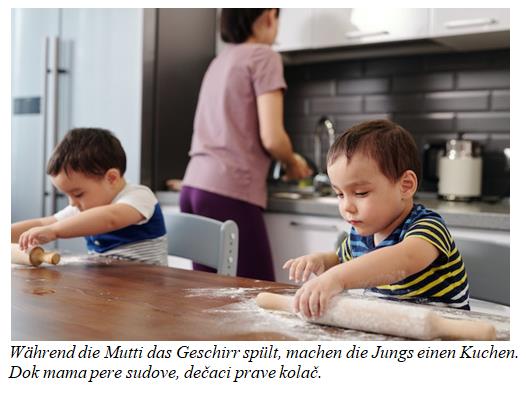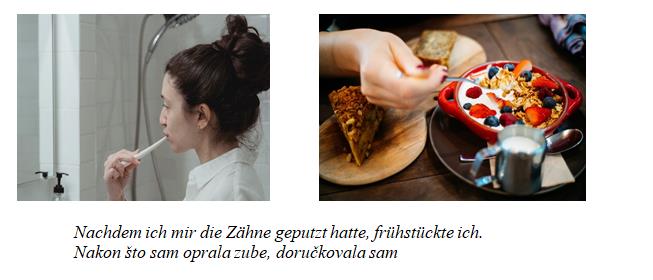In this lesson, you will learn all about temporal sentences in German. We will cover what temporal sentences are, how they are constructed, when and how they are used, and which conjunctions introduce these sentences. Additionally, we will discuss whether they are dependent or independent sentences.
Thank you for reading this post, don't forget to subscribe!CONTENTS
What are time sentences?
Als & Wenn
wärend
seitdem
bis
bevor
nachdem
What are time sentences?
Temporal sentences in German are a type of subordinating clause. The main clause and the subordinating clause have a temporal relationship.
Depending on this relationship, the action expressed in the temporal clause can occur SIMULTANEOUSLY with the action in the main clause, BEFORE it, or AFTER it. Therefore, we can distinguish between simultaneity, prematurity, and postmaturity of actions in the main and subordinating clauses.
Simultaneity: When the action in both sentences takes place at the SAME time.
For example with the conjunction während

Click on:
Grammar Contents
Prematurity: When the action of the subordinating clause takes place BEFORE the action in the main.
Example: nachdem

Postmaturity: When the action of the subordinating clause takes place AFTER the action in the main.
Example: bevor
Bevor ich zur Arbeit gehe, frühstücke ich.- Before I go to work, I have breakfast.
Therefore, the action in the subordinating sentence “going to work” takes place after the action in the main sentence. First I have breakfast, then I go to work.
Time conjunctions are: ALS, WENN, WÄREND, NACHDEM, SEIT(DEM), BEVOR, BIS … These are not all time conjunctions, there are more, but these are the ones I want to explain to you in this lesson.
Als & Wenn

Both conjunctions, “WENN” and “ALS”, are equivalent to the English word “WHEN” in various contexts, but their usage differs. Let’s explore when to use each one.
Temporal clauses using “WENN” and “ALS” express the simultaneity of two actions at a specific moment.
Subordinating clauses with “WENN” can be simultaneous or premature and refer to an action that occurred either once or repeatedly.
You can also optionally add the words “immer” (always) or “jedes Mal” (every time) to the conjunction “WENN”.
In sentences containing the conjunctions “WENN”and “ALS”, the verb is placed at the end of the sentence.
It’s important to note that “ALS” is only used for an action that happened once in the past.
Sentences using “WENN” and “ALS” answer the question “WANN?”(WHEN?).

It is possible to swap the order of the main and subordinating clause. Here are some examples.
Examples with the conjunction als:
Als er 18 war, machte er seinen Führerschein. – When he was 18, he got his driving licence.
Als ich mein erstes Gehalt bekam, kaufte ich mir italienische Stiefel. – When I got my first salary, I bought Italian boots.
Meine Schwester feierte ihren 50. Geburtstag, als wir im September in Paris waren. – My sister celebrated her 50th birthday when we were in Paris in September.
Er konnte kein Deutsch verstehen, als er zum ersten Mal in Deutschland war. – He couldn’t understand German when he was in Germany for the first time.
Examples with the conjunction wenn:
This conjunction, unlike als, can be used in the past, future and present.
Ich gehe nach Hause, wenn meine Arbeit erledigt ist. – I go home when my work is done.
Meine Mutter bereitet immer das Mittagessen zu, wenn ich von der Arbeit nach Hause komme. – My mum always prepares lunch when I come home from work.
Wenn meine Arbeit erledigt ist, gehe ich nach Hause. – When my work is done, I go home.
(Immer) wenn ich nach Triest gehe, besuche ich das Schloss Miramare. – (Whenever) I go to Trieste, I always visit Miramare Castle.
Während

Während is a temporal subordinating conjunction that connects two SIMULTANEOUS sentences. A subordinating clause introduced by “während” describes an ongoing action that does not have a definite beginning or end.
In a clause with “während,” the verb is placed at the end of the sentence. A sentence using “während” answers the question “wann?” (when?).
For example:
In the timeline, two things happen at the same time.
Während er Computerspiele spielte, gingen wir spazieren.
But the opposite can also be expressed with während.
Additionally, the structure can be reversed, allowing you to change the order of the main and dependent clauses
Here are examples:
Mia hörte immer Musik, während sie das Fahrrad fährt. – Mia always listened to music while she rode her bike.
Mirko sah fern, während seine Frau bügelte. – Mirko watched TV while his wife ironed.
Während Mia das Fahrrad fährt, hörte sie immer Musik. – Mia always listened to music while she rode her bike.
Während Mirkos Frau bügelte, sah er fern. – While Mirko’s wife was ironing, he watched TV.
Seitdem/ since, ever since, since then
Temporal clauses that use “seitdem” or “seit” express the SIMULTANEITY of two actions. In these clauses, the action in the subordinating clause starts in the past and continues into the present. The main clause is in the present tense. The relevant question words are “Seit wann?” or “Wie lange?”
Examples:
Ich arbeite in einer Schule als Deutschlehrerin, seitdem ich in Geraldton lebe. – I have been working in a school as a German teacher since I moved to Geraldton.
Ich bin arbeitslos, seitdem ich verheiratet bin. – I have been unemployed since I got married.
Sie liebt ihn, seit sie sich das erste Mal begegnet sind. – She has loved him since the first time they met.
Seitdem ich in Geraldton lebe, arbeite ich in einer Schule als Deutschlehrerin. – Since I’ve been living in Geraldton, I’ve been working in a school as a German teacher.
Seitdem wir uns das erste Mal begegnet sind, liebe ich Michael. – I’ve loved Michael ever since we first met.
Seitdem ich verheiratet bin, arbeite ich nicht. – I haven’t worked since I got married.
Seit as a prepositional construction
The temporal conjunction “seitdem” can be replaced with the prepositional construction using “seit.” “Seit” functions as a preposition that takes the dative case. It can appear at the beginning of a sentence or in another position, with its placement determined by the general rules of word order in German.
Examples:
Seit seiner Diplimprüfung arbeitet er in dieser Firma.
Er arbeitet seit seiner Diplimprüfung in dieser Firma.
– He has been working for this company since his diploma examination.
Attention: The prepositional construction will never be separated by a comma from the rest of the sentence.
Bis
The subordinating clause with bis is POST-TENSE in relation to the main clause. Bis marks the end of the action in the main sentence. In a dependent clause with bis, the verb comes at the end of the sentence.
Bis has two main English equivalents:
The subordinating clause that includes “bis” is considered POST-TENSE concerning the main clause. “Bis” indicates the conclusion of the action in the main sentence. In a dependent clause with “bis,” the verb is positioned at the end of the sentence.
“Bis” has two primary English equivalents:
– ‘until / till’: Ich warte, bis du fertig bist. – I’ll wait until you’ve finished.
– ‘by the time (when)’: Bis du zurückkommst, habe ich die Tür repariert. – I’ll have fixed the door by the time you get back.
The subordinating clause with “bis” answers the questions “Bis wann?” or “Wie lange?”
Examples:
Bis wann wartest du? – Bis die Ärztin kommt.
Until when are you waiting? – Until the doctor comes.
Wie lange wartest du? – Bis die Ärztin kommt.
How long will you wait? – Until the doctor comes.
It is also possible to swap the order of the main and subordinating clause.
For examples:
Ich warte hier, bis sie kommt.
Bis sie kommt, warte ich hier.
Bevor
The temporal conjunction “bevor” connects the main clause with the subordinating clause, indicating a time that occurs before an event (POSTMATURITY). In a subordinating clause introduced by “bevor,” the verb is placed at the end of the sentence.
For example:
Bevor ich nach Hause gehe, gehe ich einkaufen.
The clause with “bevor” answers the questions “Wann?“.
For example:
Wann gehst du einkaufen? – Bevor ich nach Hause gehe.
It is also possible to swap the order of the main and subordinating clause.
For example:
Ich gehe einkaufen, bevor ich nach Hause gehe.
Bevor ich nach Hause gehe, gehe ich einkaufen.
Attention: Even though both sentences are not simultaneous, you don’t have to pay attention to the tenses. Both sentences have the same grammatical tense.
Click on:
Grammar Contents
Nachdem

The conjunction “nachdem” connects the main clause with the subordinating clause, indicating a time that occurs before an event (POSTMATURITY). In a subordinating clause introduced by “nachdem,” the verb is placed at the end of the sentence.
Example: nachdem (Prematurity)
Nachdem Eva das Abiturgemacht hat, beginnt sie mit ihrem Studium. – After Eva graduates from high school, she begins her studies.
The clause with “nachdem” answers the questions “Wann?“.
Example:
Wann beginnt Eva mit dem Studium? – Nachdem sie das Abitur gemacht hat.
It is also possible to swap the order of the main and subordinating clause.
For example:
Nachdem Eva das Abitur gemacht hat, beginnt sie mit ihrem Studium.
Eva beginnt mit ihrem Studium, nachdem sie das Abitur gemacht hat.
In standard language usage, verb tenses must agree with the conjunction “nachdem.”
– When the main clause is in the present tense, the subordinating clause should be in the perfect tense.
– When the main clause is in the past tense or perfect tense, the subordinating clause should be in the pluperfect tense.
Examples:
Main clause = Present tense – Subordinating clause = Perfect tense
Eva beginnt mit ihrem Studium, nachdem sie das Abitur gemacht hat.
Main clause = Past or Perfect tense – Subordinating clause = Plusperfekt
Main clause = Past tense : Eva begann mit ihrem Studium, nachdem sie das Abitur gemacht hatte.
Main clause= Perfect tense : Eva hat mit ihrem Studium begonnen, nachdem sie das Abitur gemacht hatte.
Nachdem corresponds to English after.
For example:
Nachdem ich gefrühstückt habe, setze ich mich an den Schreibtisch. – After I’ve had breakfast, I sit down at my desk.
See more:

